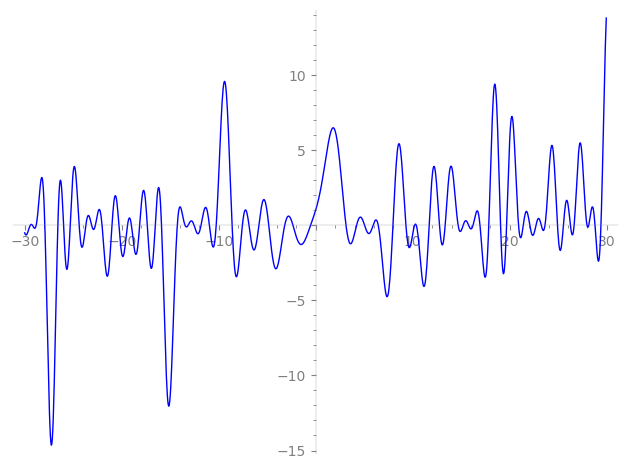| L(s) = 1 | + (1.09 − 1.09i)2-s + (−1.15 − 2.77i)3-s − 0.419i·4-s + (−4.32 − 1.79i)6-s + (−3.19 − 1.32i)7-s + (1.73 + 1.73i)8-s + (−4.27 + 4.27i)9-s + (−3.92 − 1.62i)11-s + (−1.16 + 0.483i)12-s + 0.127·13-s + (−4.96 + 2.05i)14-s + 4.66·16-s + (0.193 − 4.11i)17-s + 9.40i·18-s + (−1.81 − 1.81i)19-s + ⋯ |
| L(s) = 1 | + (0.777 − 0.777i)2-s + (−0.664 − 1.60i)3-s − 0.209i·4-s + (−1.76 − 0.731i)6-s + (−1.20 − 0.499i)7-s + (0.614 + 0.614i)8-s + (−1.42 + 1.42i)9-s + (−1.18 − 0.489i)11-s + (−0.336 + 0.139i)12-s + 0.0353·13-s + (−1.32 + 0.549i)14-s + 1.16·16-s + (0.0468 − 0.998i)17-s + 2.21i·18-s + (−0.417 − 0.417i)19-s + ⋯ |
\[\begin{aligned}\Lambda(s)=\mathstrut & 425 ^{s/2} \, \Gamma_{\C}(s) \, L(s)\cr =\mathstrut & (-0.848 - 0.528i)\, \overline{\Lambda}(2-s) \end{aligned}\]
\[\begin{aligned}\Lambda(s)=\mathstrut & 425 ^{s/2} \, \Gamma_{\C}(s+1/2) \, L(s)\cr =\mathstrut & (-0.848 - 0.528i)\, \overline{\Lambda}(1-s) \end{aligned}\]
Particular Values
| \(L(1)\) |
\(\approx\) |
\(0.278843 + 0.975079i\) |
| \(L(\frac12)\) |
\(\approx\) |
\(0.278843 + 0.975079i\) |
| \(L(\frac{3}{2})\) |
|
not available |
| \(L(1)\) |
|
not available |
\(L(s) = \displaystyle \prod_{p} F_p(p^{-s})^{-1} \)
| $p$ | $F_p(T)$ |
|---|
| bad | 5 | \( 1 \) |
| 17 | \( 1 + (-0.193 + 4.11i)T \) |
| good | 2 | \( 1 + (-1.09 + 1.09i)T - 2iT^{2} \) |
| 3 | \( 1 + (1.15 + 2.77i)T + (-2.12 + 2.12i)T^{2} \) |
| 7 | \( 1 + (3.19 + 1.32i)T + (4.94 + 4.94i)T^{2} \) |
| 11 | \( 1 + (3.92 + 1.62i)T + (7.77 + 7.77i)T^{2} \) |
| 13 | \( 1 - 0.127T + 13T^{2} \) |
| 19 | \( 1 + (1.81 + 1.81i)T + 19iT^{2} \) |
| 23 | \( 1 + (-1.24 + 3.00i)T + (-16.2 - 16.2i)T^{2} \) |
| 29 | \( 1 + (-1.87 - 4.53i)T + (-20.5 + 20.5i)T^{2} \) |
| 31 | \( 1 + (-4.95 + 2.05i)T + (21.9 - 21.9i)T^{2} \) |
| 37 | \( 1 + (0.677 + 1.63i)T + (-26.1 + 26.1i)T^{2} \) |
| 41 | \( 1 + (-3.85 + 9.29i)T + (-28.9 - 28.9i)T^{2} \) |
| 43 | \( 1 + (1.79 + 1.79i)T + 43iT^{2} \) |
| 47 | \( 1 + 4.59T + 47T^{2} \) |
| 53 | \( 1 + (-1.15 + 1.15i)T - 53iT^{2} \) |
| 59 | \( 1 + (-4.34 + 4.34i)T - 59iT^{2} \) |
| 61 | \( 1 + (1.54 - 3.73i)T + (-43.1 - 43.1i)T^{2} \) |
| 67 | \( 1 + 6.88iT - 67T^{2} \) |
| 71 | \( 1 + (6.66 - 2.76i)T + (50.2 - 50.2i)T^{2} \) |
| 73 | \( 1 + (13.5 - 5.59i)T + (51.6 - 51.6i)T^{2} \) |
| 79 | \( 1 + (-4.75 - 1.97i)T + (55.8 + 55.8i)T^{2} \) |
| 83 | \( 1 + (-10.2 + 10.2i)T - 83iT^{2} \) |
| 89 | \( 1 - 0.600iT - 89T^{2} \) |
| 97 | \( 1 + (-7.09 + 2.93i)T + (68.5 - 68.5i)T^{2} \) |
| show more | |
| show less | |
\(L(s) = \displaystyle\prod_p \ \prod_{j=1}^{2} (1 - \alpha_{j,p}\, p^{-s})^{-1}\)
Imaginary part of the first few zeros on the critical line
−10.95936203196906266180767940893, −10.25763685894852466992426269810, −8.620641928037959646057885726302, −7.55926076430548854227821563484, −6.87966185322867216650353381198, −5.85959859904603681352865213882, −4.84174280849863631614505161165, −3.19258145530383497867413745915, −2.34993668814233669331597728526, −0.52374188253941021362318866029,
3.12040055019942836396081918676, 4.21257295970486329772306430847, 5.03188283846200327011698799871, 5.91678434856671129960860559937, 6.44216340262551403006813654420, 7.961484196767599509787967904374, 9.297012514194475460344567057999, 10.19621053812046514477109046871, 10.36089350255167513542645734464, 11.69085867855818363087342304604

